Automated Guided Vehicle Market Size, Share, Industry, Statistics & Growth by Type (Tow Vehicles, Unit Load Carriers, Forklift Trucks, Assembly Line Vehicles, Pallet Trucks), Navigation Technology (Laser Guidance, Magnetic Guidance, Vision Guidance), Industry, Region - Global Forecast to 2028
The global automated guided vehicle market size is estimated to be valued USD 2.4 billion in 2023 and is projected to reach USD 3.3 billion by 2028, at a CAGR of 6.9% from 2023 to 2028. The growth of e-commerce and the need for efficient warehouse operations have driven the demand for AGVs in material handling and logistics. AGVs are used for tasks such as goods transportation, pallet handling, and order picking in distribution centers. The adoption of new technology and the push toward smart manufacturing have increased the demand for automation solutions, including AGVs. AGVs play a crucial role in implementing flexible and connected manufacturing systems.
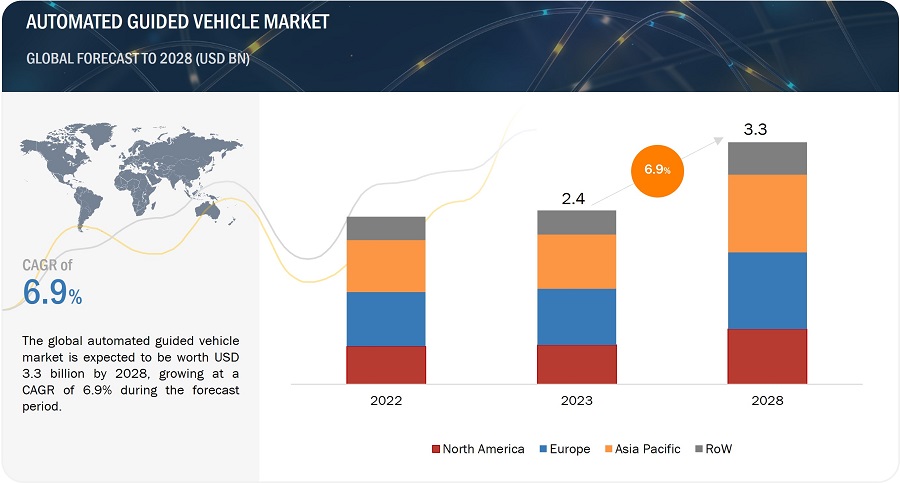
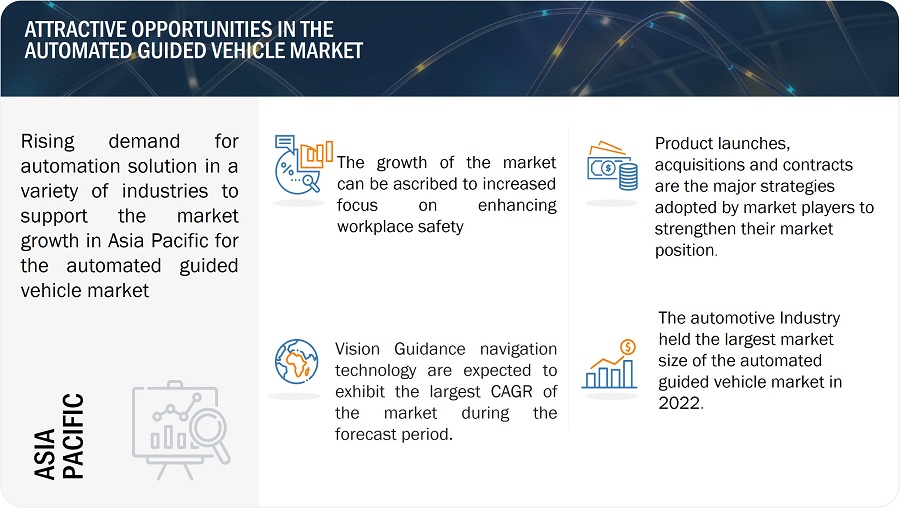
Automated Guided Vehicle Market Forecast to 2028
To know about the assumptions considered for the study, Request for Free Sample Report
Highest Growing Segments and Applications:
AGVs Industry Trends Shaping the Future:
Automated Guided Vehicle Market Trends
Driver: Remarkable shift to mass customization from mass production
Due to globalization, several industries are shifting to mass customization from mass production. The frequently changing lifestyle of people, varying regulatory standards in different countries, and evolving customer demand for various products across the globe are the factors that are driving the companies to adopt customizations on a large scale to meet their customer demands. Unlike traditional manufacturing, these companies cannot have a standard design of a product to be manufactured. The companies have to modify their production facilities, customize the product designs, and accordingly customize their processes to meet clients' requirements. This leads to the need to make infrastructure and process changes, thereby increasing business expenses. In cases where conveyor systems are used, the changes in infrastructure can be a tedious and costly affair. On the other hand, implementing AGVs to carry out the transportation of materials allows the process to be flexible, thus keeping the costs low, and increasing efficiency and profit margins. Hence, the shift to mass customization is driving the AGV market growth.
Restraint: High installation, maintenance, and switching costs associated with AGVs
Huge capital expenditure is required to install and set up AGVs. The high cost can discourage manufacturing companies from choosing high-end AGVs. Small enterprises cannot afford automated systems and, hence, opt for traditional/manual handling forklift trucks. Additionally, the cost of maintaining AGVs, which varies according to the age, type, location, number of shifts per day, and condition of the equipment, also acts as a barrier to the growth of this market. For instance, AGVs used in the manufacturing, chemicals, and construction industries have a high maintenance cost. Moreover, it is difficult for companies to invest in automation solutions due to high capital spending and a long payback period.
The costs associated with the overall setup of AGV systems are high as these vehicles are programmed and require navigation and communication systems to interact with other material handling equipment. The average payback period for AGVs usually ranges from 3 to 5 years. Therefore, it is difficult for many companies to invest in AGVs due to high capital spending and a long payback period. Furthermore, warehouse operators need to change warehouse layouts to support AGV systems. While designing new layouts, companies need to focus on key aspects such as worker safety, space utilization, and easy accessibility to items. Companies spend a considerable amount on infrastructure development. Thus, the impact of the high setup cost on the growth of the AGV market is considered to be high. Determination of the exact number of AGVs required is another important consideration for deploying AGVs across an industrial facility. As material handling requirement in some industries fluctuates according to the market demand or their production cycle, companies cannot precisely predict the number of AGVs required in their facilities. Thus, high capital investment acts as a key restraint for the growth of the AGV market.
Opportunity: Increasing focus on industrial automation by SMEs
The initial cost of AGV solutions is high, depending on the integrated battery type and navigation technology. Small and medium-sized enterprises (SMEs) find it difficult to adopt automation technologies in material handling due to the high initial cost, and these technologies are mostly affordable to large-scale industries. Factors such as rising labor costs (in developed economies like the US), quality concerns, and limited skilled workforce hinder the growth and profitability of these SMEs. Therefore, despite high initial capital investments, SMEs are moving toward automated warehouse operations as automation helps them compete globally with bigger market players. AGVs can help SMEs to be more competitive and deliver significantly enhanced levels of productivity, efficiency, and profitability. Many SMEs have started investing in AGVs to increase their global competitiveness. Similarly, SMEs from the e-commerce, automotive, food & beverages, pharmaceuticals, and chemicals industries are expected to deploy AGVs in the coming years.
Challenge: Technical challenges related to sensing elements
The real-time technical challenges related to any sensing element in material handling equipment could stop the entire process. For instance, an AGV will not react to provided commands effectively if the sensing element of the AGV is not installed correctly. Failure of the sensor in this system would halt the entire process as a sensor is the most critical element of any AGV system for navigation and other operations. Moreover, any fault in the control software may lead to improper functioning of the AGVs; this could delay the entire production process. Mechanical failures can result from improper maintenance, causing loss of production and performance. Hence, regular maintenance is crucial for the smooth functioning of AGVs.
Market Ecosystem
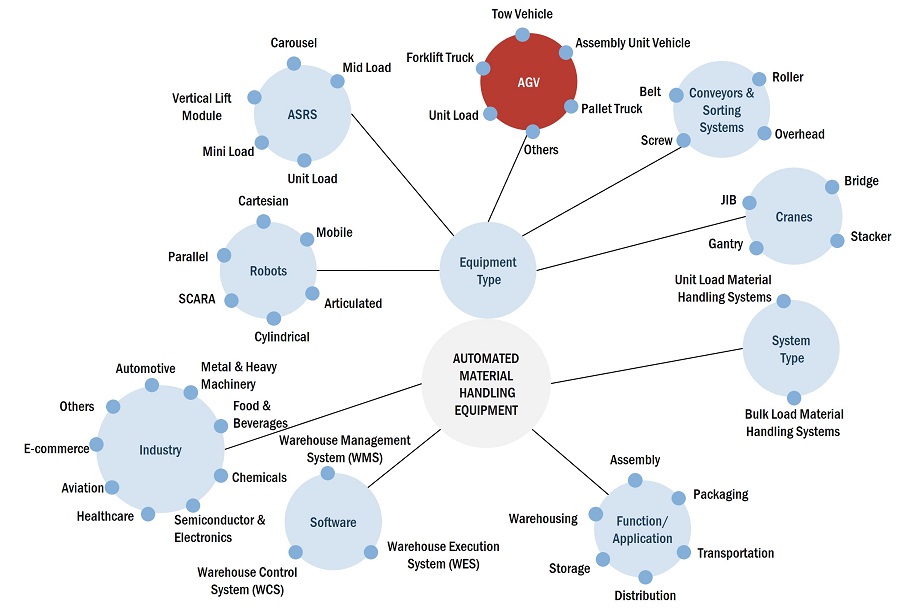
Automated Guided Market Market: Key Trends
Daifuku, JBT, KION, Toyota Industries, KUKA are the top players in the AGV market. These AGV companies with advance robotics and AI technology trends and navigation technology with a comprehensive product portfolio and solid geographic footprint.
Tow vehicle segment held the largest market size of automated guided vehicles in 2022
The tow vehicles segment held the largest share of the AGV market share in 2022. Tow vehicles are a specific type of AGV designed for towing or pulling material handling carts, trailers, or other payloads within a facility. These AGVs are equipped with a towing mechanism, such as a tow bar or hitch, which connects to the load they are meant to transport. Tow vehicles offer flexibility in transporting a variety of materials, products, or goods. They are versatile and can be adapted for different industries and applications, including manufacturing, warehousing, and distribution.
Laser guidance segment to maintain the largest share in the market during forecast period.
The laser guidance navigation technology account for the largest share in the market during forecast period. Laser guidance technology is a popular method used in AGVs for navigation and positioning within industrial environments. It enables AGVs to follow predetermined paths accurately, avoid obstacles, and navigate through dynamic environments. AGVs equipped with laser guidance technology are fitted with laser scanners or sensors. These devices emit laser beams and detect reflections from targets or surfaces in the environment. Laser guidance technology is widely used in various industries, including manufacturing, logistics, and distribution, where AGVs are employed for material handling and transportation tasks. It offers a reliable and efficient solution for navigating AGVs in complex and dynamic environments.
Asia Pacific region to record the highest CAGR of AGV Market from 2023 to 2028.
The Asia Pacific region has experienced significant growth in the AGV market in recent years, driven by factors such as industrial automation, the expansion of manufacturing industries, and the increasing adoption of AGVs for material handling and logistics. The rise of e-commerce and the growth of the logistics and warehousing sector have fueled the adoption of AGVs for efficient and automated material movement within distribution centers. AGVs are vital in optimizing warehouse operations and improving overall logistics efficiency. The automotive industry, a significant contributor to manufacturing in the Asia Pacific region, has embraced AGV technology for tasks such as material transportation, assembly line operations, and logistics within automotive plants.
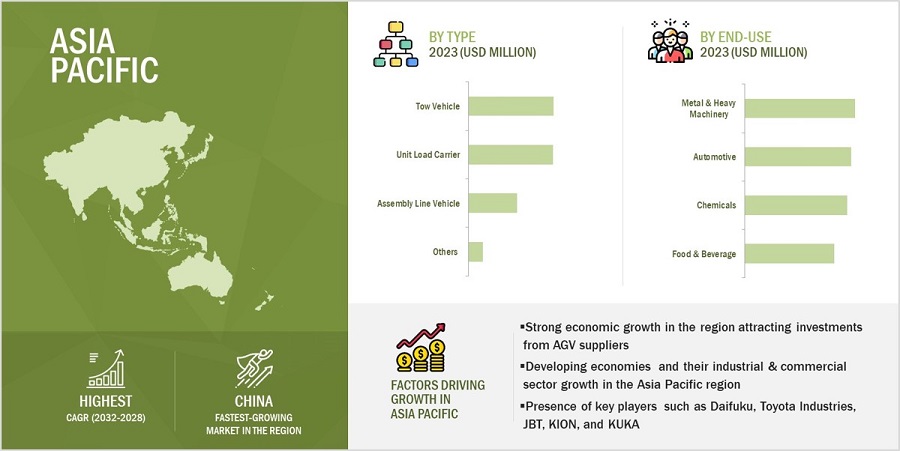
Automated Guided Vehicle Market by Region
To know about the assumptions considered for the study, download the pdf brochure
Global Deployment Metrics:
Sector-Specific Penetration Rates:
Key Market Players
The major companies in the Automated Guided Vehicle companies are Daifuku, JBT, KION, Toyota Industries, KUKA, Hyster-Yale Materials Handling, Oceaneering International and EK Robotics are among others. Leading the charge in AGV innovation, key players such as KLM Automation, TechnoBotics, and Precision Robotics are continually pushing the boundaries. KLM Automation, for instance, introduced the AGV-5000 series, boasting advanced navigation systems and machine learning algorithms, contributing to enhanced operational efficiency. These companies collectively hold a substantial market share, driving the evolution of AGV technology. These companies have used both organic and inorganic growth strategies, such as product launches, acquisitions, and partnerships to strengthen their position in the automated guided vehicle market.
Get online access to the report on the World's First Market Intelligence Cloud
- Easy to Download Historical Data & Forecast Numbers
- Company Analysis Dashboard for high growth potential opportunities
- Research Analyst Access for customization & queries
- Competitor Analysis with Interactive dashboard
- Latest News, Updates & Trend analysis
Request Sample Scope of the Report
Get online access to the report on the World's First Market Intelligence Cloud
- Easy to Download Historical Data & Forecast Numbers
- Company Analysis Dashboard for high growth potential opportunities
- Research Analyst Access for customization & queries
- Competitor Analysis with Interactive dashboard
- Latest News, Updates & Trend analysis
|
Report Metric |
Details |
| Estimated Market Size | USD 2.4 billion in 2023 |
| Projected Market Size | USD 3.3 billion by 2028 |
| Growth Rate | CAGR of 6.9% |
|
Years Considered |
2019–2028 |
|
Base year considered |
2022 |
|
Forecast period |
2023–2028 |
|
Forecast units |
Value (USD million/billion) |
|
Segments Covered |
Type, Navigation Technology, Industry, and Region |
|
Regions covered |
North America, Asia Pacific, Europe, and Rest of the World |
|
Companies covered |
Daifuku (Japan), JBT (US), KION (Germany), Toyota Industries (Japan), KUKA (Germany). |
Automated Guided Vehicle Market Highlights
In this report, the overall automated guided vehicle market has been segmented based on Type, Navigation Technology, Industry, and Region
|
Segment |
Subsegment |
|
By Type |
|
|
By Navigation Technology |
|
|
By Industry |
|
|
By Region |
|
Recent Developments
- In April 2023, EK Robotics launched MEDI MOVE, a new transport platform for the healthcare industry. With its customized design and high performance, the MEDI MOVE has been designed as an Automated transport system in hospitals. These AGVs navigate through underground route networks and over several floors to deliver to hospital wards, sterile departments, and nursing areas.
- In September 2022, Toyota Industries launched the lift truck, an AI-based technology that automatically recognizes the location and position of trucks and loads and generates automated travel routes to perform loading operations.
- In April 2021, JBT introduced warehouse freezer AGV, which can operate in an array of temperatures, from -10ºF to 110ºF. Offering operations a lift capacity of 2,500 pounds, the automatic guided vehicle features a triple stage hydraulic mast, which has an integrated side shift and tilt.
Frequently Asked Questions (FAQ):
What will be the global automated guided vehicle market size in 2023?
The automated guided vehicle market is expected to be valued USD 2.4 billion in 2023.
Who are the global automated guided vehicle market winners?
Companies such as Daifuku, JBT, KION, Toyota Industries, KUKA fall under the winners’ category.
Which region is expected to hold the highest global automated guided vehicle market share?
Europe will dominate the global automated guided vehicle market in 2023. The growth of the European AGV market is mainly driven by the significant investments made by automotive players in robotic systems and AGVs.
What are the major drivers of the automated guided vehicle market?
Rising demand for automation solution in a variety of industries, increased focus on enhancing workplace safety, and marked shift to mass customization from mass production.
What are the major strategies adopted by AGV companies?
The companies have adopted product launches, acquisitions, expansions, and contracts to strengthen their position in the market.
What are the key trends shaping the AGV market in recent times?
The AGV market is witnessing transformative trends, including the integration of advanced technologies such as Artificial Intelligence (AI) and the Internet of Things (IoT). These trends focus on enhancing navigation systems, increasing connectivity, and adapting AGVs to specific industry needs, marking a shift towards more intelligent and efficient automated solutions.
Are there growth opportunities for businesses in the AGV market?
The AGV market presents significant growth opportunities for businesses, especially those involved in AI-driven navigation systems, innovative AGV applications, and solutions catering to emerging markets. As industries increasingly prioritize automation for operational efficiency, businesses offering cutting-edge AGV technologies are well-positioned to capitalize on this growing demand.
What are the highest growing sectors for AGV adoption?
The e-commerce sector leads in AGV adoption, boasting an impressive 80% penetration rate, followed closely by the automotive industry, where AGVs are employed in over 60% of manufacturing facilities. These sectors showcase the highest growth potential for AGV applications, driven by the need for streamlined and automated material handling processes.
Can you provide insights into the future of AGV technology and its impact on industries?
The future of AGV technology promises even greater integration of AI, advanced navigation systems, and increased connectivity through IoT. Industries like healthcare, pharmaceuticals, and food and beverage are expected to witness significant AGV adoption, showcasing the technology's broadening impact on diverse sectors.
How has the AGV market responded to the challenges posed by the COVID-19 pandemic?
The AGV market exhibited resilience during the COVID-19 pandemic, experiencing a notable 15% growth in 2020. Businesses sought AGVs as a solution for more resilient and automated material handling, contributing to the industry's adaptability to challenging circumstances.
How are AGVs contributing to sustainability goals within logistics operations?
AGVs contribute to sustainability goals within logistics operations by not only reducing carbon emissions by 20% but also optimizing energy consumption, reducing waste through precise material handling, and promoting overall eco-friendly practices within logistics operations.
What types of AGVs are prevalent in the market, and how do they differ in applications?
Various types of AGVs, such as unit load carriers, tow vehicles, and pallet trucks, are prevalent in the market. These differ in applications, with unit load carriers ideal for material transport, tow vehicles for moving multiple carts, and pallet trucks for handling palletized goods.
How do AGVs contribute to increased safety in industrial environments?
AGVs enhance safety in industrial environments through features such as collision avoidance systems, laser scanners, and sensors. These technologies ensure safe navigation, minimizing the risk of accidents and promoting a secure working environment.
Are AGVs suitable for small and medium-sized enterprises (SMEs), or are they more tailored for large corporations?
AGVs are suitable for businesses of all sizes, including small and medium-sized enterprises (SMEs). Their scalability and adaptability make them cost-effective solutions for SMEs while providing scalability for larger corporations with complex logistics needs.
What are the key challenges faced by the AGV industry, and how are they being addressed?
Key challenges faced by the AGV industry include initial setup costs, security concerns, and regulatory compliance. Industry leaders are addressing these challenges through collaborative efforts, standardization, and continuous innovation in technology.
How does AGV technology impact supply chain resilience, especially in the face of disruptions such as natural disasters or geopolitical events?
AGV technology enhances supply chain resilience by offering flexibility in material handling and reducing dependency on manual labor. During disruptions such as natural disasters or geopolitical events, AGVs contribute to maintaining operational continuity, ensuring a more resilient supply chain.
How are AGVs addressing the need for sustainability in logistics, beyond just carbon emissions reduction?
Beyond carbon emissions reduction, AGVs contribute to sustainability in logistics by optimizing energy consumption, reducing waste through precise material handling, and promoting overall eco-friendly practices within logistics operations. These efforts align with global sustainability initiatives, making AGVs not just efficient but also environmentally responsible solutions in the logistics landscape.
To speak to our analyst for a discussion on the above findings, click Speak to Analyst
The study involves four major activities that estimate the size of the automated guided vehicle market. Exhaustive secondary research was conducted to collect information related to the market. Following this was validating these findings, assumptions, and sizing with the industry experts across the value chain through primary research. Both top-down and bottom-up approaches were employed to estimate the overall size of the automated guided vehicle market. Subsequently, market breakdown and data triangulation procedures were used to determine the extent of different segments and subsegments of the market.
Secondary Research
Secondary sources in this research study include corporate filings (such as annual reports, investor presentations, and financial statements); trade, business, and professional associations; white papers, certified publications, articles from recognized authors; directories; and databases. The secondary data were collected and analyzed to estimate the overall market size, further validated by primary research. The relevant data is collected from various secondary sources, it is analyzed to extract insights and information relevant to the market research objectives. This analysis has involved summarizing the data, identifying trends, and drawing conclusions based on the available information.
Primary Research
In the primary research process, numerous sources from both supply and demand sides were interviewed to obtain qualitative and quantitative information about this report. The primary sources from the supply-side included various industry experts such as Chief X Officers (CXOs), Vice Presidents (VPs), and Directors from business development, marketing, product development/innovation teams, and related key executives from automated guided vehicle providers, (such as Daifuku, JBT, KION, Toyota Industries, KUKA) research organizations, distributors, professional and managed service providers, industry associations, and key opinion leaders. Approximately 25% of the primary interviews were conducted with the demand side and 75% with the supply side. These data were collected mainly through questionnaires, emails, and telephonic interviews, accounting for 80% of the primary interviews.

To know about the assumptions considered for the study, download the pdf brochure
Market Size Estimation
In the market engineering process, both top-down and bottom-up approaches were implemented, along with several data triangulation methods, to estimate and validate the size of the automated guided vehicle market and other dependent submarkets listed in this report.
- The key players in the industry and markets were identified through extensive secondary research.
- Both the supply chain of the industry and the market size, in terms of value, were determined through primary and secondary research.
- All percentage shares, splits, and breakdowns were determined using secondary sources and verified through primary sources.
Market Size Estimation Methodology-Bottom-up Approach


Data Triangulation
After estimating the overall market size, the total market was split into several segments. The market breakdown and data triangulation procedures were employed wherever applicable to complete the overall market engineering process and gauge exact statistics for all segments. The data were triangulated by studying various factors and trends from both the demand and supply sides. The market was also validated using both top-down and bottom-up approaches.
Market Definition
Automated guided vehicles (AGVs) are portable, automatic vehicles and load carriers that can travel on the floor without a manual operator. They are used for material handling in various industries. These vehicles safely handle and transport all kinds of products, eliminating the requirement for human intervention in production, logistic, warehouse, and distribution environments. They increase the efficiency and productivity of industries, as well as reduce product damages and labor costs. AGVs are an integral part of manufacturing processes and are indispensable in the material handling industry.
The AGV ecosystem comprises manufacturers of AGV products and solutions. The AGV market is diversified, consisting of companies from different regions of the world competing across its value chain to sustain their position and increase their market share. The AGV market is likely to witness significant growth in the coming years due to the surging demand for automation in the automobile, e-commerce, healthcare, and other key industries.
Stakeholders
- AGV manufacturers
- End users
- Government bodies, venture capitalists, and private equity firms
- Manufacturers of sensors, microcontrollers, RFID modems, and related accessories
- Material handling associations
- Professional service/solution providers
- Research institutions and organizations
- Standards organizations and regulatory authorities related to the material handling industry
The main objectives of this study are as follows:
- To define, describe, and forecast the global automated guided vehicle (AGV) market, in terms of value, by type, navigation technology, region, and industry
- To forecast the market size, in terms of value, by region—North America, Europe, Asia Pacific (APAC), and the Rest of the World (RoW)
- To provide detailed information regarding the major factors influencing the growth of the market, namely, drivers, restraints, opportunities, and industry-specific challenges
- To strategically analyze the micromarkets1 with respect to individual growth trends, prospects, and contributions to the total market
- To study the complete value chain of the AGV ecosystem, along with market trends and use cases
- To analyze opportunities in the market for stakeholders by identifying high-growth segments of the global AGV market
- To strategically profile key players and comprehensively analyze their core competencies2 along with detailing the competitive landscape for market leaders
- To analyze competitive developments such as product launches, acquisitions, partnerships, and expansions in the global AGV market
- To benchmark market players using the company evaluation quadrant, which analyzes players based on various parameters within broad business categories and product strategies
Available Customizations:
With the given market data, MarketsandMarkets offer customizations according to the specific requirements of companies. The following customization options are available for the report:
Country-wise Information:
- Analysis for additional countries (up to five)
Company Information:
- Detailed analysis and profiling of different market players (up to five)


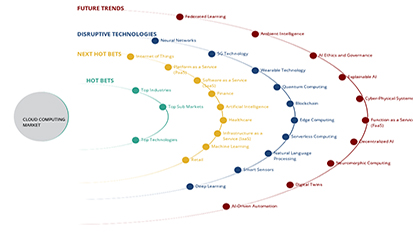

 Generating Response ...
Generating Response ...







Growth opportunities and latent adjacency in Automated Guided Vehicle Market